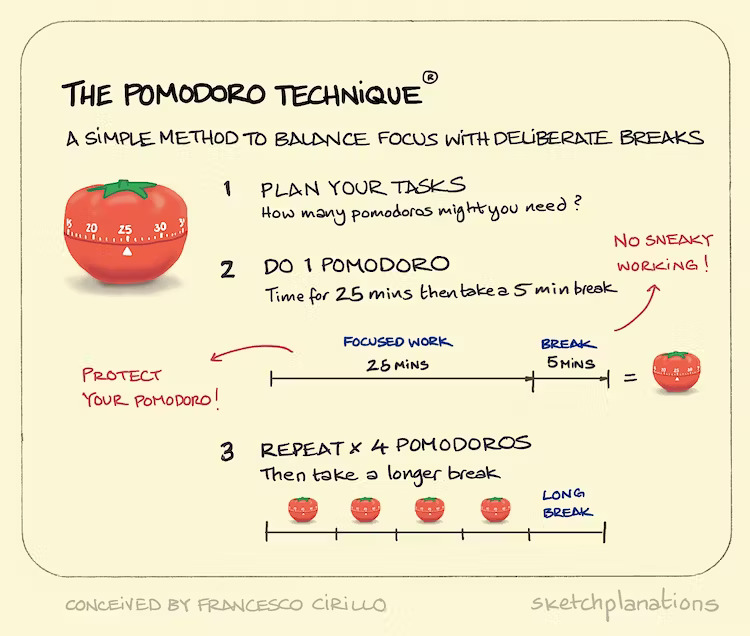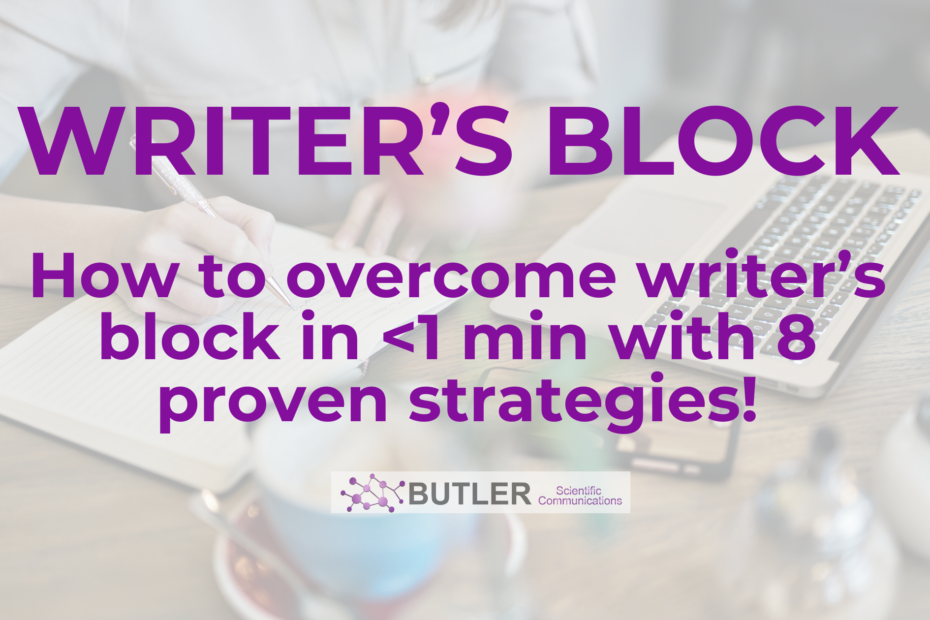While many tips for how to overcome writer’s block are preventative in nature and include things like setting up good writing habits and routines, these are long-term solutions that don’t help if what you really need is words on paper right now.
So this first installment in my series on overcoming writer’s block provides my best 8 tips for how to overcome writer’s block INSTANTLY!
These 8 tips cover everything from helping you break cycles of procrastination to taking your draft less seriously.
More importantly, all can be implemented in less than 1 minute to help you get words on paper right now, exactly when you need them!

Watch this post as a video!
1. Change font to Comic Sans
There is something about an unserious font that is great at reminding us that our draft is just that – a draft. And it is a lot easier to write when we don’t take our writing so seriously.
So, stop taking your writing so seriously, especially if you are struggling to put words on paper.
How? Change your font to Comic Sans, and watch the words flow!
I learned this tip from the novel-writing community, where it is revered as an instant way to overcome writer’s block, and can confirm, it also works for science papers.
Though I was initially skeptical and my eyeballs definitely HATE is (who wants to stare at Comic Sans all day?), this tip is first for a reason – when I need to write and can’t, Comic Sans takes the seriousness out of writing, which helps the words flow right out of me and onto the page.
For editing, though, I always change it back. 🙂
Overcome writer's block INSTANTLY, tip #1: If staring at your document isn't helping you get words on paper, try taking your draft less seriously - change your FONT to COMIC SANS and watch the words flow!
Kaycie at ButlerSciComm Tweet
2. Count to 10 and start
Sometimes writer’s block is just procrastination.
You know those days – where you’re not actually STUCK, just doing little things that are easier sources of dopamine than forcing yourself to do the challenging task of writing.
My go-to for these days?
I recognize that I am procrastinating, take a deep breath, count to 10, and then I start.

That’s it. That’s the trick.
And don’t knock it until you try it – I kept this one untested for ages because I thought “no way this works.”
Well, I am living proof that it does in fact work, and also works consistently over years. There is something about recognizing what I am doing and then giving my brain that 10 count (as slow as I need) to make peace with it and wrap up any lingering thought that allows me to return my focus to the project I am avoiding.
Overcome writer's block INSTANTLY, tip #2: Get back on track when procrastinating by: Recognizing you are procrastinating, Taking a deep breath, Counting to 10, Starting back to work!
Kaycie at ButlerSciComm Tweet
3. Write in timed chunks (Pomodoro)
Most people have heard of this tip already for overcoming writer’s block, as the Pomodoro technique has become quite ubiquitous.
And that is for a really good reason – it works.
If you are struggling to write for any reason, set a timer, and do not allow yourself to move away from that task until the timer is complete.
The traditional Pomodoro technique has you set a timer and focus on your project for 25 minutes, then take a 5 minute break. After 4 rounds, you take a longer 30 min break.
No joke, I now break ALL of my work into “Pomodoros” – meaning I break all of my tasks into how many ~30 min chunks I think I will need to complete it and use that to schedule my days.

This technique works by keeping you focused on a task for long enough to accomplish something meaningful – your attention must be focused on your task for 25 whole minutes, which is definitely long enough to accomplish something!
One key part of this technique though – the breaks need to be respected! Meaning – don’t force yourself to do timed sessions back to back to back with no breaks – the breaks are important to help clear your head and rest. So while you can play around with when you take breaks and how long those breaks are, you don’t want to skip them entirely!
CAVEAT – the strict Pomodoro might not work for you, but don’t stop that from trying this technique anyways.
For instance, for me, a timer that rings and fixed 25-min chunks don’t work – sticking this strictly to the Pomodoro can interrupt my flow state, so I prefer to use a countdown timer that doesn’t ring in case I get into the flow of my work and want to continue for a bit longer. Often, my first session of the day will be closer to 50 minutes, after which I take a longer break (~15 min), and then get into closer-to-regular Pomodoro chunks.
To make the Pomodoro technique work for you, play around with:
- length of the working times
- length of breaks
- whether or not to use a timer
- Your timer options: real timer (i.e., kitchen timer), online timer, or downloaded desktop timer
- Whether or not your timer rings to tell you the time period is over.
Now I know roughly how long I need for each part of a paper or grant and can schedule my timed sections accordingly. I have a timer downloaded on my computer so I don’t need to stress about going to a website (distracting!), and I don’t let that timer ring – preferring only to check it when I am feeling like I need a break to see if I need to keep working to reach my minimum set working time (25 min).
Overcome writer's block INSTANTLY, tip #3: Make sure you focus long enough to get writing done by writing in TIMED CHUNKS with set breaks. With the Pomodoro technique, you do 4 rounds of 25 min writing w/a 5 min break, and then take a 30 min break.
Kaycie at ButlerSciComm Tweet
4. Switch to pen and paper
Like the tip for switching to Comic Sans to reduce how serious and final your draft seems, sometimes switching away from a digital text editor is all you need to unstick your thoughts and overcome writer’s block.
Turns out, even typing a “draft” on a computer looks more fancy than my thoughts feel sometimes, and my less-than-organized initial thoughts benefit from the ability to physically scratch out text, mark it up in pen, draw circles around key points, or use arrows to “move” ideas to a new location.
As this is all easier for me to do on pen and paper, this is a great way for me to get my initial thoughts down before they are in a form that works well with Word.
So, next time you are having a hard time writing, try switching to good ol’ pen and paper.
In fact, in addition to hundreds of notes on my phone, I keep a notebook with me at all times that gets pulled out anytime I am stuck. I now have stacks of these notebooks that are full of text written every which way across pages, drawings, dog-ears, and have sticky notes crawling out from everywhere. This is one of the top ways I’ve found for “unsticking” myself in any creative project – not just writing.
So next time you are at the store, grab a cheap notebook and a pen you love the feel of in your hands, and try to get some words down the old fashioned way!

Overcome writer's block INSTANTLY, tip #4: Help the words flow faster and with less friction by switching to PEN and PAPER! This form is more associated with drafts and imperfect writing, so it can decouple the process from the polished final product.
Kaycie at ButlerSciComm Tweet
5. Freewrite
Freewriting, or just writing continuously whatever comes to mind for a set period of time, is a great way to overcome writer’s block by shaking loose new ideas or getting some text out that can act as a seed for more and better text.
The main point here is to just FORCE yourself to put literally any words on paper.
For me, I set a Pomodoro timer and challenge myself to take almost no breaks – I just type constantly during this time. Yes, this often gives you a stream-of-consciousness text that is mostly not useful for your project, but it CAN get you useful text, and is regardless a fast way for getting into writing and sorting through your mental space.
I love this technique because I find really quickly that it is often just a mental barrier blocking me from writing that suddenly seems much less daunting when I see it written out in black and white (and maybe I act a bit as my own therapist diagnosing some issues and mental blocks along the way, but that is neither here nor there…).
More importantly, just writing out WHY I can’t write often leads me to directly what I might need to do to fix it, which I can sometimes even fix DURING that freewriting session. I don’t know about you, but I think that’s super cool and almost a super power!
A bit more about this technique – it works really well in conjunction with both Pomodoro timers and pen and paper writing, if either of those options appeal to you. Definitely take the time to explore and find what works for you, though. For instance, I tend to do it mostly on a computer because I can type faster than I write, and I find it is speed that helps me the most when freewriting because what I often really need is to organize thoughts or work through a mental barrier.
Example: how freewriting can overcome writer's block instantly
As an example, here is some of my freewriting text that I saved because I thought it was cool how I worked this out so quickly when I had been procrastinating on writing this paragraph for…ages (with details and some of the more extensive profanity removed 😉 ):
“So here we are again freewriting because I hate this stupid project and don’t care enough to get stupid words on paper but apparently I have to. And so here I am getting stupid words on stupid paper. Stupid words, Stupid paper, Stupid Word, stupid project, stupid job, blah blah blah blah blah. I want to make a new tea but here I am stupid freewriting first instead…
D*ammit okay I need to focus on this project. Ugh but I have no idea what to write right now. Ok, like, I kind of know what I want to say, but I don’t want to. Or no, I do want to. So what is it? I guess I don’t know how to write it. Why? I guess it doesn’t seem to really fit with how the rest of the text was organized and how I wrote it. F*ck do I have to go back and re-write everything? [I removed a bit here where I explored this because its more of this.] Okay, so no, I do think I am writing it the best way.
Okay, so maybe I am having a hard time writing because I don’t know how this paragraph fits into the rest of the work. So what do I want to say here? Like, really what are the main points? Well, I need to tell the reader XXX. And probably YYY. Hmmmmm….. okay, but I can see how it doesn’t really fit so well now because the paragraph before seems like it contradicts YYY. Oh, well, maybe I can start it like that… like “Conversely…” and show the evidence that also speaks for YYY. And then I can say XXX and ZZZ…like, I don’t HAVE to start with XXX even though that was the plan here. XXX still works fine as evidence for the main point here. Oh, that might work… okay, so what would that paragraph look like…let’s see…
[Draft paragraph reflecting what I just wrote above].”
So in this freewriting session, I went from being frustrated and acting out a temper tantrum against my project to actually having a draft of the exact text I needed and was able to plug directly into the project. Yes, this text wasn’t perfect and needed edited, but it was text and it did solve my problem.
Yes, I also swear and call my projects names. Its how I get into the flow of freewriting. Don’t judge – its part of my process.
And more importantly, because my goal when freewriting is just to keep typing all the time, this entire chunk of copied text took me MAYBE 10 minutes to write.
10 minutes, folks. 10.
And I managed to get a draft of a paragraph that was responsible for my procrastination for probably hours if not more realistically, for days.
So, what are you waiting for? Set a timer and get to freewriting!
Overcome writer's block INSTANTLY, tip #5: If your words are stuck, try to force something out with FREEWRITING. Set a timer, and write continuously until it goes off. Capture everything that is running through your head and see what comes out!
Kaycie at ButlerSciComm Tweet
6. Move your body for at least 60 seconds
Similar to taking a break, getting up and getting your heart pumping can also help alleviate some of the blocks that are stopping you from writing.
Next time you are stuck or having a hard time writing, stand up and do something that gets your heart pumping for at least 60 seconds.
My preferred technique here is something I’ve taken from yoga: a standing, moving twist in which you swing your arms around your body, one to the front and one to the back, and switch back and forth while building speed (see the image below for an example). Don’t knock it ’till you try it – this one gets the blood flowing, wakes me up, and stretches out those back kinks from being at the desk.
But hey, don’t restrict yourself to what works for me! You can do anything here – so find something that works for you to help overcome writer’s block!
I work with someone who uses this time to get in a minute of squats and others who prefer jumping jacks or pushups, burpees (yikes!), and someone who puts together a list of exercises that they want to do in a day and works through them.
Whatever you choose, pick something that can get your blood pumping in about a minute, and watch what happens to your creativity after this short break combined with increased blood flow!
Overcome writer's block INSTANTLY, tip #6: Get your blood pumping! Stand up from your desk and MOVE for at least 60 seconds. Think jumping jacks, squats, pushups, burpees, or whatever your body is craving, and only try writing again when your blood is flowing!
Kaycie at ButlerSciComm Tweet
7. Record a chat with a friend (or yourself!)
Have you ever noticed that sometimes we can speak so clearly about a topic that we can’t seem to get words on paper for?
Or maybe that sometimes we can write better after talking AT another person for a bit, because it helped us sort your thoughts?
If either of these is also true for you, recording your conversations with your friends might be what you need to overcome writer’s block get those words on paper!
This one takes a bit more time, but is often well worth the effort when you can walk away from a 30 min chat with an outline for what you need to write.
So how do you do it?
- Invite a friend for coffee, letting them know you’d need an ear to listen to you chat
- Record your conversation (or ask your friend to take notes if that makes you feel weird)
- Talk to them about what you are trying to write
- Take your recording/notes from this chat and convert to text!

So I won’t lie to you here – I did this exactly ONCE and it worked beautifully.
But why did I stop at once?
I realize that for me, I often just need to talk things out, out loud, to sort through my thoughts for writing. The chat with the friend was really helpful, but I get the same effect by just telling myself the story out loud and recording or taking notes of any particularly good or helpful parts.
And you can do this, too – if you want to be writing right now but don’t have any friends available at the moment for a chat, try talking out loud to yourself like your friend is sitting there.
Now I can save my coffee trips with friends for catching up AND I get my writing done. 🙂
Overcome writer's block INSTANTLY, tip #7: Chat about your writing to a friend (or out loud to yourself!) and RECORD the convo or have your friend take notes! Use this convo to organize your thoughts and you might just end up with a "spoken" draft!
Kaycie at ButlerSciComm Tweet
8. Skip around in your project
Sometimes, what is keeping us from writing is just a specific part of that text or project, but we’d be able to write other parts of the text.
If you realize that its not writing in general that is blocking you from getting text on paper today, but that writing THIS specific thing is where you are stuck, then you might be able to overcome writer’s block by skipping that chunk of text for now and coming back to it later.
A good way to do this is to include a bracketed placeholder, indicating what you skipped and potentially any notes you want to leave to future you about what you want or need to include in this section.
For instance:
“[Describe the state-of-the-art of XXX and show why this technique still needs work.]“
The unfortunate thing here is that you will eventually need to come back to this text, and it might just be a tricky section that future you now has to deal with, but I do still use this technique regardless because sometimes when I come back to a paragraph once the rest of the text has been sorted, it is much easier to write.
So maybe if the section of text you are working on is what is holding you back, find another section today where words are more readily flowing!
Overcome writer's block INSTANTLY, tip #8: If you are stuck on one part of text, try making a note in brackets and MOVING ON. Sometimes these parts get easier later, and if you can get words on paper elsewhere, you can make better use of your time by skipping around.
Kaycie at ButlerSciComm Tweet
Spread the love, share your methods!
Finally, I am one person and can only generate so many ideas. So, help us generate a library of possible strategies by telling us what helps YOU overcome your writer’s block instantly.
Have a good set of movements that get the blood pumping? Tell us your system in the comments!
Use a non-traditional version of the Pomodoro Technique? Comment with how you modified it to work for you!
Something I missed? Let us know!


